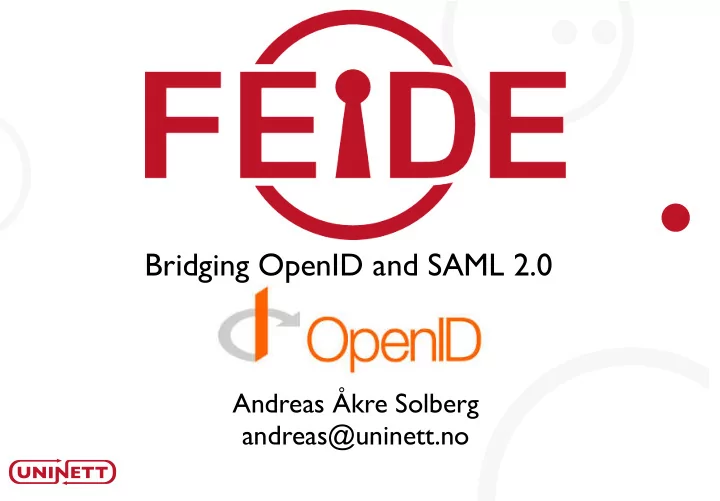

Bridging OpenID and SAML 2.0 Andreas Åkre Solberg andreas@uninett.no
Terminology OpenID Terminology OpenID OpenID OpenID Consumer Identity Provider SAML 2.0 Terminology SAML 2.0 SAML 2.0 Service Provider Identity Provider
What is your OpenID? Your identity - is your web site URL! http://rnd.feide.no is my OpenID identity. • You can control over what you put on that URL. • The URL is globally unique. • It is one aspect of your identity.
User centric OpenID is centric around the user, not centric around a specific IdP or federation. OpenID consumers works with all possible OpenID providers - no need for trust relationship in advance - basicly consumers does not have to trust the provider, they trust the user ! The user can switch to another IdP at any time...
No trust? There is no trust in OpenID. A site can never really know who you are - instead the site can know that you are the very same person that registered an account.
Target group: services World wide services where everyone can create "anonymous" accounts, but there is a need to protect the account with credentials: as yahoo, aim, flickr, facebook, digg, technorati ++ (world wide and too large to possibly join every possible federation out there) Lightweight accounts: comments on blogs, public wikis, polls etc. (too small to join a complex SAML2.0 federation)
The open in OpenID OpenID is "open". • No federation • Anyone can become an OpenID consumer (Service) • Anyone can become an OpenID provider (IdP) • All OpenID providers can authenticate users for all consumers (no groups/federations/circles of trust) - just one big network where everyone is connected...
Why? Why introduce OpenID in our closed but happy federated environment? • Convinient for users! Many more services increases the usefullness of federated SSO. • These services would never be SPs. • It is not a competing technology - it will be an extension to our federations. We don't replace SAML with OpenID, we extend with OpenID.
Why OpenID? Independent Not bound to specific vendor. Simple The spec is only a few pages.
How does it work On the OpenID address web site, you add some meta headers about your OpenID provider: This is an abstraction layer that allows you to switch Identity Provider re-using the same OpenID identifier.
How does it work When you visit an OpenID consumer, you are asked about your OpenID URL: Then the consumer contacts that URL, extract the openid meta headers, and now have the address of the OpenID provider.
Two modes There is two modes: smart mode and dumb mode Smart mode is for consumers that can keep state. Dumb mode is for consumers that are stateless.
Smart mode OpenID Identity 1. lookup() OpenID OpenID 2. associate() Consumer Provider (4. authenticate) 3. Send checkid_setup 3. checkid_setup 5. response 5. response UA Shared key is exchanged in advance using DH in the associate() call.
Dumb mode OpenID Identity 1. lookup() OpenID OpenID 6. check_authenticated() Consumer Provider (4. authenticate) 3. Send checkid_setup 3. checkid_setup 5. response 5. response UA Shared key is exchanged in advance using DH in the associate() call.
OpenID <-> SAML 2.0 OpenID Identity 1. lookup() 4. AuthnRequest OpenID simple SAML 2.0 6. check_authenticated() Consumer SAMLphp IdP 3. Send checkid_setup 3. checkid_setup 4. AuthnResponse 5. response 5. response UA Shared key is exchanged in advance using DH in the associate() call.
Security considerations Phishing? Not different from other web sec mechs. Some counter attacks: native browser support, infocard++. No trust? We don't need it, we have SAML too ;) DNS attack on consumer If you care much about securing your accounts, your OpenID identity + OpenID server should be on HTTPS.
Recommend
More recommend